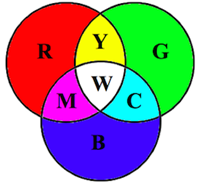Getting your Trinity Audio player ready...
Hold down the T key for 3 seconds to activate the audio accessibility mode, at which point you can click the K key to pause and resume audio. Useful for the Check Your Understanding and See Answers.
Mission LC7 Pigments and Color Subtraction - Question Group 3 Help

Three colored spotlights - red, green and blue - with equal intensities are used to illuminate a shirt with different colors of light. Cyan pigment is imparted to a shirt and it is then illuminated with green and blue light. The shirt will appear ____.
(Note: The actual colors are randomly generated and may differ from those listed above.)
(Note: The actual colors are randomly generated and may differ from those listed above.)

Color Subtraction and Primary Pigments:
Primary pigments are painted onto or fixed within objects to subtract (absorb) one or more of the three primary colors of light. Any light color that shines on the paper and is not subtracted (absorbed) becomes reflected. This reflected light contributes to the color appearance of the object.
Primary pigments are painted onto or fixed within objects to subtract (absorb) one or more of the three primary colors of light. Any light color that shines on the paper and is not subtracted (absorbed) becomes reflected. This reflected light contributes to the color appearance of the object.

 Many students of physics have seen a diagram similar to the one shown at the right. The diagram depicts three circles colored with the primary colors of light - red, green and blue. The primary colored circles overlap to produce other colors of light, known as the secondary colors of light: cyan (C), magenta (M) and yellow (Y). These three colors - C, M, Y - are also the three primary colors of paint. The colors of light that they absorb are those directly opposite them on the color wheel. Cyan pigment absorbs red light. Magenta pigment absorbs green light. And yellow pigment absorbs blue light.
Many students of physics have seen a diagram similar to the one shown at the right. The diagram depicts three circles colored with the primary colors of light - red, green and blue. The primary colored circles overlap to produce other colors of light, known as the secondary colors of light: cyan (C), magenta (M) and yellow (Y). These three colors - C, M, Y - are also the three primary colors of paint. The colors of light that they absorb are those directly opposite them on the color wheel. Cyan pigment absorbs red light. Magenta pigment absorbs green light. And yellow pigment absorbs blue light.
The pigment in the paper is capable of absorbing a primary color of light. The color wheel in the Dig That Diagram section can help you determine what color of light the pigment can absorb. If that color of light is shining on the paper, then it will not be reflected. The other color(s) of light shining on the paper will be reflected. The reflected light determines what color the paper will appear.
